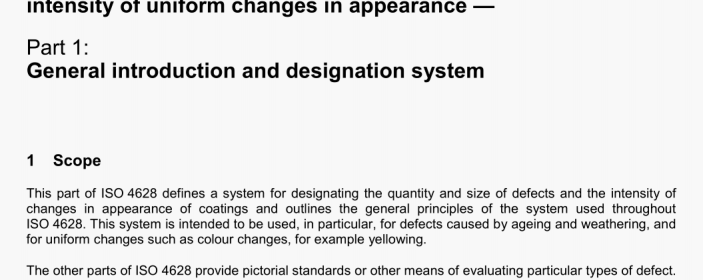General introduction and designation system

BS EN ISO 4628-1:2003 pdf free.Paints and varnishes – Evaluation of degradation of coatings一Designation of quantity and size of defects, and of intensity of uniform changes in ap pearance- Part 1: General introduction and designation system.
This part of IsO 4628 defines a system for designating the quantity and size of defects and the intensity of changes in appearance of coatings and outlines the general principles of the system used throughout ISO 4628. This system is intended to be used, in particular, for defects caused by ageing and weathering, and for uniform changes such as colour changes, for example yellowing.
The other parts of ISO 4628 provide pictorial standards or other means of evaluating particular types of defect.
As far as possible, already existing evaluation schemes have been used as the basis.
This part of ISO 4628 can also be used for assessing defects not covered by the other parts of ISO 4628.
2 General principles of the designation system A uniform convention has been adopted for designating the quantity and size of defects and the intensity of changes by means of ratings on a numerical scale ranging from 0 to 5, 0 denoting no defects or changes, and 5 denoting defects or changes so severe that further discrimination is not reasonable. The other ratings,corresponding to the numbers 1, 2, 3 and 4, are so defined that they give optimum discrimination over the whole range of the scale.
The use of intermediate half-steps is permissible, if specified, to give a more detailed report on the defects or changes observed.
NOTE 1 The quantity of small defects scattered over the test area may be assessed by means of a grid method.
Details of such a method are described in ISO 4540, Metallic coatings一Coatings cathodic to the substrate一Rating of electroplated test specimens subjected to corrosion tests.
NOTE 2 The ISO ranking may be different from the ranking schemes used in other standards, e.g. the rusting evaluation ASTM D 610, Standard Test Method for Evaluating Degree of Rusting on Painted Steel Surfaces, where ranking is from 10 to 1, with 10 meaning no change and 1 meaning greatest change.In addition to the ratings, the approximate dimensions of the area concerned shall be given, or the proportion of the area concerned compared with the total area, expressed as a percentage.
3 Assessment of defects and of intensity of changes
3.1 General Carry out the assessment under good ilumination.
3.2 Designation of quantity of defects
The quantity of defects in the form of discontinuities or other local imperfections in the coating, scattered over the test area in a more or less even pattern, is designated in accordance with Table 1. The ratings shall be expressed as a whole number unless otherwise specified (see Clause 2).
3.3Designation of size of defects The average size (order of magnitude) of defects is designated, if required and meaningful, in accordance with Table 2.
Where a test area exhibits defects of various sizes, the size of the largest defects which are numerous enough to be typical of the test area shall be quoted as the size rating. The size of the defect shall be reported using the designation Sn where S indicates the size and n is the rating number. For example, a defect which is just visible with normal corrected vision is designated S2.
3.4 Designation of intensity of changes The intensity of uniform changes in the appearance of the coating, such as colour changes, for example yellowing, is designated in accordance with Table 3. The ratings shall be expressed as a whole number unless otherwise specified (see Clause 2).
4 Expression of results
The type of defect, the quantity present (Table 1) and its size (Table 2) shall be expressed as indicated in the following examples:
blistering; degree of blistering 2(S2);
flaking; degree of flaking 3(S2);
together with the approximate dimensions of the area concerned, or its proportion of the total area, expressed as a percentage.
If necessary, the test result may be amplifed in words, for example“confined to edges” or “blistering of top coat down to intermediate coat ‘
The type of change and its intensity (Table 3) shall be expressed as indicated in the fllowing example:chalking 4;
together with the approximate dimensions of the area concerned, or its proportion of the total area, expressed as a percentage.
5 Test report
The test report shall contain at least the fllowing information:
a) all details necessary to identify the coating examined;
b) a reference to this part of ISO 4628 (ISO 4628-1:2003);
C) the type of surface examined, its size and, if appropriate, its location;
d) the result of the assessment in accordance with Clause 4;
e) an indication of the ilumination under which the assessment was carried out;
f) any unusual features (anomalies) observed during the assessment;
g) the date of the examination.BS EN ISO 4628-1 pdf free download.General introduction and designation system